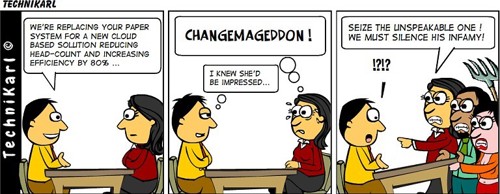When done well, change can see the difference between a successful anti-climax (that’s a good thing) that delivers real business value and one that causes abject chaos striking fear and confusion into the hearts of those who were just not prepared for it.
Some years ago, I created the below comic strip as a bit of fun to highlight the danger of not having recipients of change on the journey with you! (While I’d love to claim I actually put pen to paper and drew the comic strip, I just used an online comic strip generator, yes that’s a thing, who knew?).

Making the case for change can be challenging, especially when the status quo is seen to be above criticism or improvement.
The status quo
In the world of change, the passion for the ‘status quo’ can often be the one where most resistance occurs and is usually the one that is met with plaintive cries of ‘Why change it if it’s not broken?’ Or ‘Hold on, we’ve always done it that way...’
You can take the classic ‘form in triplicate’ as an example. You have three separately coloured but identical versions of the same document. If you were to ask why a form is needed in triplicate, would anyone really know the answer?
Is it perhaps more likely that form 1 is actioned, form 2 is filed for reference but never checked, as form 1 was also filed and form 3 is sent to the paranoia department who like to ensure they know what is going on?
Finally, the form is scanned by each department and held digitally in their local system just waiting to be printed off on another sheet of paper should the need arise, which, of course, never does. If no one questions the methods behind the process or the value it offers then rarely will it see improvement but instead be accepted as ‘That’s just the way we do things round ‘ere.’
Take them with you
Overcoming resistance to change requires careful thought and planning. These are often articulated as project risks to be mitigated, but they should be seen as part of the overall project delivery - perhaps a sub-project in itself - that will require dedicated focus and attention to address. Bear in mind that you may be the change agent for a deeply ingrained, and perhaps cherished custom. No one will thank you for trumpeting your planned change without consultation or some acknowledgement that change may be difficult for those on the receiving end.
Winning hearts and minds takes time and effort; there are few short-cuts to this and while you can’t please everyone, every effort should be made to demonstrate you at least tried. Change is always about people’s willingness to understand, accept and, ultimately, feel that they are on the journey with you. To what degree they actually feel this is entirely down to you as the change owner and the effort you put into making the change something that others just can’t wait to be a part of.












